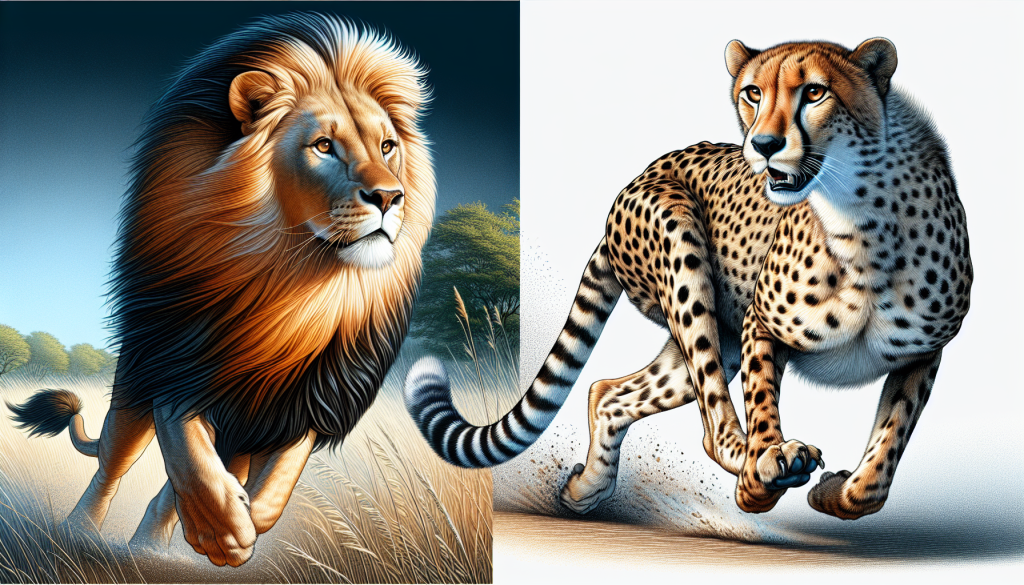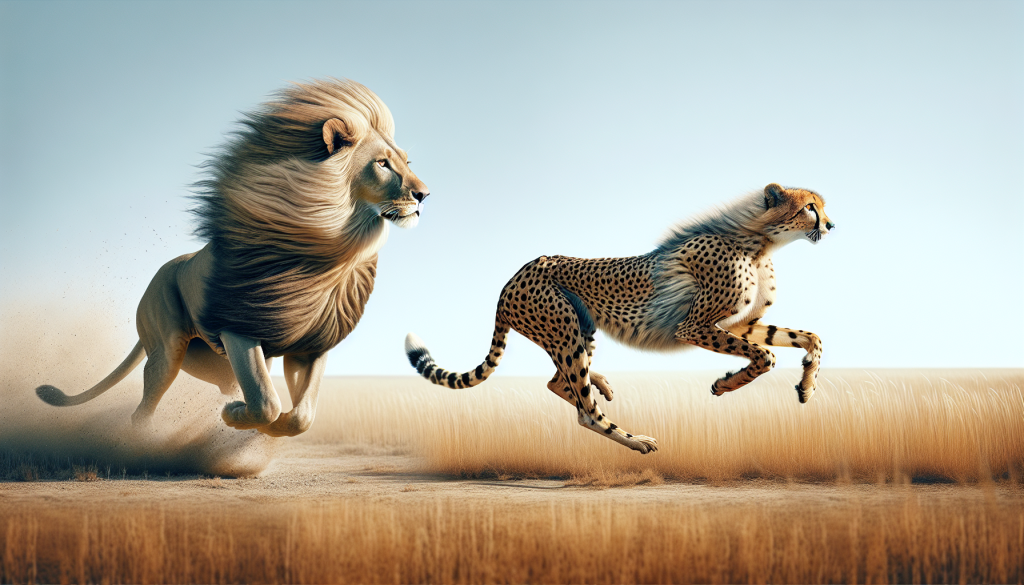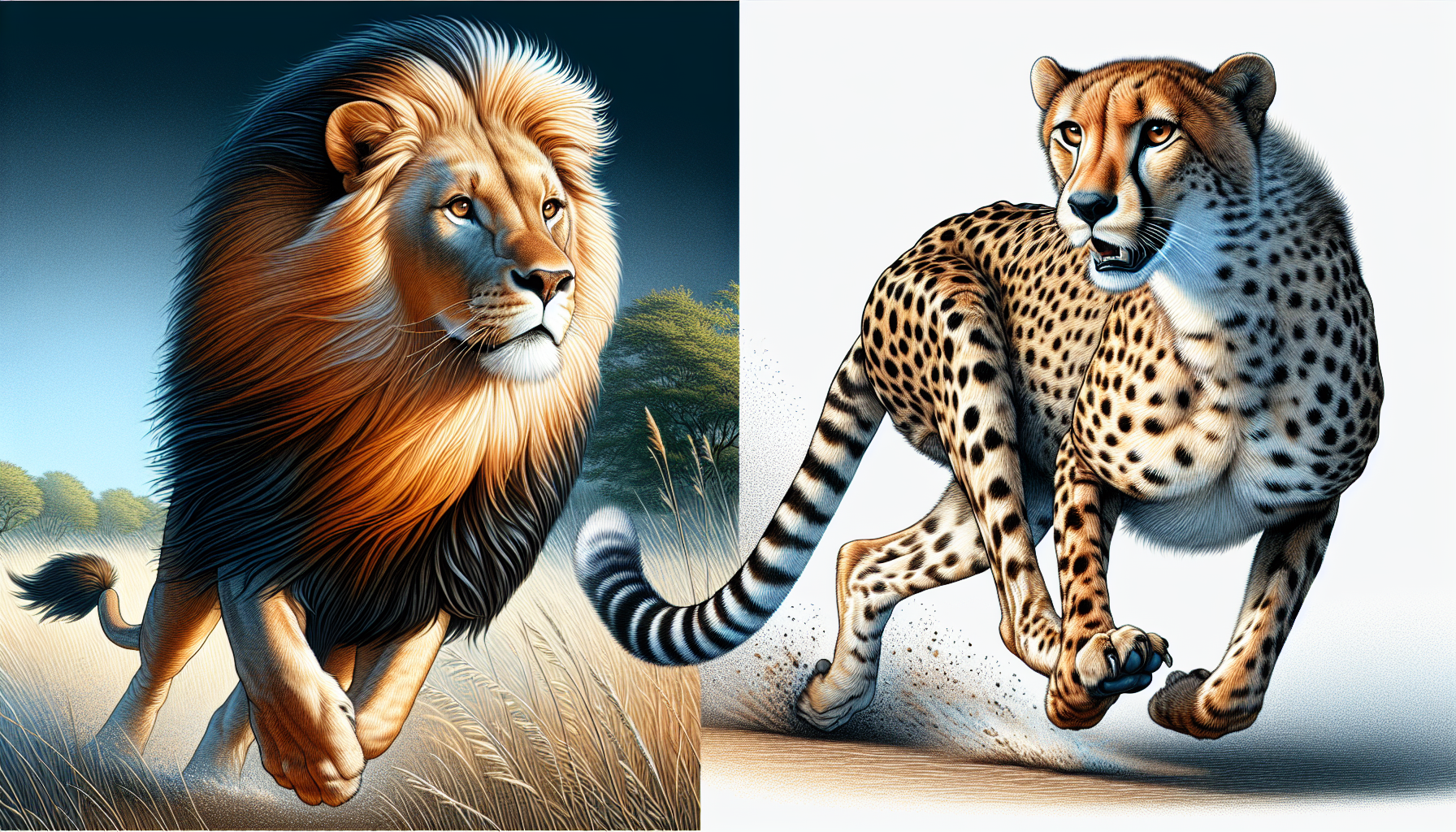Ever wondered about the distinctive traits that set a lion and a cheetah apart? While both these majestic creatures belong to the big cat family, their physical appearances, hunting techniques, and social behaviors couldn’t be more contrasting. From the powerful manes of lions to the lightning-fast speed of cheetahs, exploring the disparities between these two magnificent species will unravel a fascinating tale of adaptability and survival in the wild.

Size
Body Size
When it comes to size, lions and cheetahs have some noticeable differences. Adult male lions are larger than adult male cheetahs, standing at around 3.9 to 4.9 feet tall at the shoulder and weighing between 330 and 500 pounds. On the other hand, adult male cheetahs are usually smaller, measuring approximately 2.5 to 3 feet tall at the shoulder and weighing between 80 and 140 pounds. As for females, lionesses are also larger than their cheetah counterparts. Female lions stand at around 3.6 to 4.3 feet tall at the shoulder and weigh between 265 and 400 pounds, while female cheetahs measure about 2 to 2.5 feet tall and weigh between 60 and 110 pounds.
Weight
While adult male lions certainly outmatch male cheetahs in terms of weight, it’s worth noting that both species have different body compositions. Lions are more robust and muscular, whereas cheetahs are slimmer and feature a leaner build. This difference in body structure is due to the roles they play in their respective habitats and their hunting techniques, which we will explore further later in the article.
Appearance
Coat Pattern
One of the most striking differences between lions and cheetahs is their coat pattern. Lions have a tawny-colored coat, often described as a sandy or golden brown, which helps them blend into the dry grasslands of their natural habitats. Another distinguishing feature of a lion’s coat is the presence of a prominent mane in adult males. The mane varies in color from blond to dark brown or black and adds to the lion’s majestic appearance. Cheetahs, on the other hand, display a unique black tear-like mark that runs from the inner corner of their eyes down to the sides of their muzzle. Their short fur is covered in solid black spots on a golden or tawny background, providing excellent camouflage for their hunting style.
Mane
Perhaps one of the most recognizable features of a lion is its majestic mane. The mane starts to develop around 1 year of age in male lions. As they mature, the mane becomes fuller and darker, serving as an indication of their dominance and maturity. The mane not only enhances the lion’s appearance but also provides some protection during confrontations with other lions. However, not all male lions have impressive manes. Certain factors, such as genetics and testosterone levels, affect the size and fullness of the mane.
Tail
Both lions and cheetahs possess tails, but their tails serve different purposes. A lion’s tail is long and ends with a tuft of fur, contributing to its overall regal appearance. The tail’s primary function is to serve as a communication tool, particularly when hunting in a group. Lions use their tails to signal each other, coordinating their movements during hunts or when defending their territory. On the other hand, a cheetah’s tail is comparatively longer and more slender. It acts as a rudder, providing balance and stability during its high-speed chases. The cheetah’s tail helps it make agile twists and turns as it pursues its prey.
Habitat
Natural Range
Lions and cheetahs have overlapping yet distinct natural ranges. Lions are more commonly found in grassy plains, savannahs, and open woodlands across Africa, with a small population residing in the Gir Forest Sanctuary in India. Cheetahs, on the other hand, have a wider distribution, occupying a variety of habitats, including grasslands, savannahs, deserts, and even some mountainous regions. Cheetahs can be found in parts of Africa, such as Botswana, Namibia, and South Africa, as well as in Iran.
Preferred Environment
Lions and cheetahs have unique preferences when it comes to their habitat. Lions are social animals that form prides, preferring habitats with abundant prey, access to water sources, and ample cover for hunting and resting during the day. They are often associated with open grasslands and savannahs, where their group hunting strategies can be effectively utilized. In contrast, cheetahs are solitary animals and rely on their incredible speed and agility for hunting. They favor more open landscapes, such as grassy plains and deserts, which provide them with a clear line of sight to spot and pursue their prey.
Diet
Carnivorous Diet
Both lions and cheetahs are carnivorous predators, but their hunting techniques and dietary preferences differ. Lions are skilled hunters that rely on cooperative efforts to bring down larger prey species. Their diet primarily consists of large ungulates, such as zebras, wildebeest, and buffalo. Cheetahs, on the other hand, are specialized hunters that focus on smaller and more agile prey. Their diet mainly includes small to medium-sized ungulates, such as gazelles and impalas. They are more selective in their prey choices and tend to target healthy individuals to increase their hunting success.
Hunting Techniques
Lions and cheetahs employ different hunting techniques based on their unique physical attributes and hunting strategies. Lions rely on their strength, stamina, and group coordination to take down larger prey. They utilize a combination of ambushing, stalking, and chasing techniques, often working together to isolate and overpower their target. Cheetahs, on the other hand, rely on their extraordinary speed and agility to excel in high-speed chases. They are known for their incredible acceleration and can sprint at incredible speeds of up to 70 miles per hour! Cheetahs use their remarkable acceleration and maneuverability to get as close as possible to their prey before launching a lightning-fast pursuit.

Speed and Agility
Sprinting Abilities
When it comes to sheer speed, cheetahs are unparalleled in the animal kingdom. As mentioned earlier, cheetahs can reach incredible speeds of up to 70 miles per hour in just a few seconds, covering distances of up to 1,500 feet in a single sprint. This extraordinary sprinting ability allows cheetahs to close the distance on their prey rapidly, increasing their chances of a successful hunt. On the other hand, lions are not built for the same level of speed. While they can reach speeds of up to 50 miles per hour over short distances, their strength and endurance are better suited for group hunting and bringing down larger prey.
Stamina
While cheetahs excel in short bursts of explosive speed, their stamina is relatively low compared to lions. Sprinting at such high speeds requires a tremendous amount of energy and results in rapid exhaustion for cheetahs. After just 20-30 seconds of pursuit, a cheetah needs significant time to recuperate and catch its breath before it can resume its activities. However, lions, with their muscular build and slower but steadier pace, possess greater stamina. They can maintain a steady gait for longer distances, allowing them to keep up with migrating herds or persistently track their prey until exhaustion.
Social Behavior
Group Structure
Lions and cheetahs exhibit strikingly different social behaviors. Lions are highly social animals and live in groups known as prides. These prides consist of related females, their offspring, and a coalition of one or more dominant males. The pride structure provides several advantages, including increased hunting success, defense against rival predators, and better protection for the young. In contrast, cheetahs are solitary animals, with the exception of females raising their young. Male cheetahs are typically loners, maintaining a solitary lifestyle even outside the mating season.
Communication
Both lions and cheetahs rely on communication within their respective groups, although their methods differ. Lions use a variety of vocalizations, including roaring, growling, and purring, to communicate with each other. These vocalizations serve to maintain social bonds, establish territories, coordinate group movements during hunts, and communicate with their young. Cheetahs, on the other hand, rely more on visual signals and body language to communicate. They use facial expressions, posturing, and tail movements to convey messages, particularly during encounters with other cheetahs or while courting potential mates.
Reproduction
Breeding Habits
Breeding habits differ significantly between lions and cheetahs. Lions are polygamous, with dominant males often mating with multiple females within the pride. When a new male lion takes over a pride, he may kill any cubs sired by the previous dominant male to ensure his own genetic lineage. In contrast, cheetahs are generally monogamous and form temporary bonds with a single partner during the mating season. Once mating is complete, the male cheetah usually has no further involvement in raising the cubs.
Gestation Period
The gestation period of lions and cheetahs is similar, lasting for approximately 90 to 110 days. However, there are slight variations. Lionesses give birth to a litter of 1 to 6 cubs, with an average litter size of 2 to 4 cubs. In contrast, cheetahs usually have smaller litters of 3 to 5 cubs, although larger litters may occur. Due to their solitary nature and the lack of protection offered by a pride, cheetah cubs face higher mortality rates compared to lion cubs.
Number of Offspring
On average, lions give birth to slightly larger litters compared to cheetahs. Lionesses often have multiple cubs in a single litter, whereas cheetahs typically have fewer offspring. This difference can be attributed to the varying levels of parental care and the advantages of group living that lionesses within a pride can provide to their young.
Lifespan
Average Lifespan
The lifespan of lions and cheetahs can vary based on a range of factors, including habitat conditions, predation, and overall health. Lions typically have a shorter lifespan than cheetahs, with an average life expectancy of 10 to 14 years in the wild. However, lions in protected areas and captivity may live longer, reaching up to 20 years or more. Cheetahs, in comparison, have a shorter average lifespan of 10 to 12 years in the wild, but their lifespan in captivity can extend to 17 years or more.
Conservation Status
Threats
Both lions and cheetahs face considerable threats to their survival in the wild. Lions are listed as vulnerable by the International Union for Conservation of Nature (IUCN), primarily due to habitat loss, human-wildlife conflict, and prey depletion. Additionally, trophy hunting and poaching for the illegal wildlife trade pose significant dangers to lion populations. Similarly, cheetahs are also classified as vulnerable by the IUCN, primarily due to habitat loss, conflict with humans, and the illegal trade of live cheetahs or their body parts.
Population
Estimating the exact population numbers for lions and cheetahs is a challenging task due to their wide distribution and the remoteness of some of their habitats. However, both species have experienced significant population declines over the years. It is estimated that there are around 23,000 to 39,000 lions left in the wild, with the majority residing in protected areas. Cheetahs, on the other hand, are believed to have a population of less than 7,000 individuals in the wild, making them even more vulnerable to extinction.
Interaction with Humans
Cultural Symbolism
Lions hold deep cultural and symbolic significance in various human cultures around the world. Known as the “King of the Jungle,” lions are often associated with strength, power, and royalty. They feature prominently in folklore, mythology, and religious symbolism, seen as majestic and noble creatures. Their regal appearance and their association with leadership have made them symbols of national pride and are often used as mascots for sports teams, on national flags, and in popular culture. Cheetahs, although not as widely romanticized, are also admired for their speed and agility.
Human-Wildlife Conflict
The increasing overlap between human settlements and lion or cheetah habitats has led to heightened human-wildlife conflict. As human populations expand, lions and cheetahs face habitat encroachment, resulting in greater competition for resources and increased incidents of livestock predation. This conflict often leads to retaliation by farmers, who may resort to killing lions or cheetahs to protect their livelihoods. Conservation efforts are essential to finding sustainable solutions that minimize these conflicts and ensure the coexistence of humans and these magnificent big cats.
In conclusion, while lions and cheetahs may share similarities as large carnivores, their distinct characteristics set them apart. Lions are known for their impressive size, majestic appearance, and group-living dynamics, while cheetahs are recognized for their incredible speed, lean build, and solitary lifestyle. Understanding these differences allows us to appreciate the remarkable diversity within the feline family and highlights the importance of conservation efforts to protect these iconic species for future generations.

